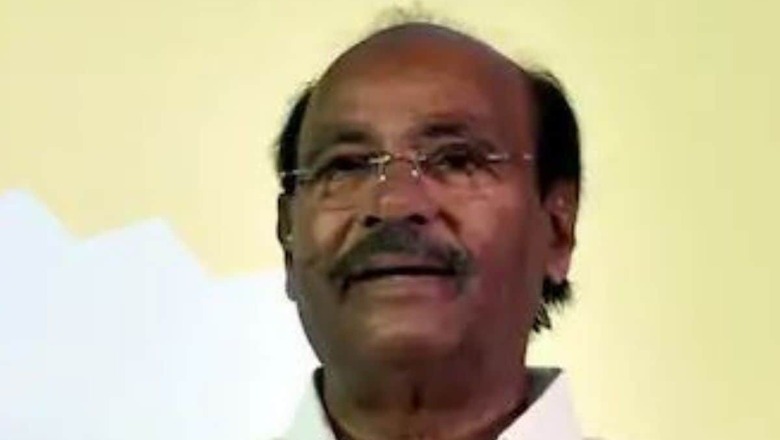
views
The Pattali Makkal Katchi (PMK) has been a shrewd operator in the Tamil Nadu electoral scene. Run by Dr S. Ramadoss and his son Dr Anbumani Ramadoss, it has a support base comprising a group of castes collectively called the Vanniyar and is based largely in northern Tamil Nadu.
Dr Ramadoss is very decisive. He has sided with both the dominant parties—the DMK (Dravida Munnetra Kazhagam) and the AIADMK (All India Anna Dravida Munnetra Kazhagam)—in the past. He has also contested elections on his own to see what his actual strength is. In the 2016 Assembly election, he went solo and was soundly defeated in every seat across the state. In the previous three elections, he was with either the DMK or the AIADMK, and it was always the PMK that sealed the first deal with the dominant party, in terms of number of seats.
The Vanniyar community is the largest by number in Tamil Nadu. While the caste census data has not been made public, the community claims to constitute 15-20 per cent of the state population. In the 1980s, Ramadoss and his men were embroiled in a violent protest across northern Tamil Nadu, demanding separate reservation for Vanniyars. The enraged community ransacked public transport, blocked roads with large tree trunks and dug up roads to stop the movement of long-distance buses. The agitation ran for months, resulting in deaths of several people.
But it did highlight a long-held grouse: that the 50 per cent reservation prevalent in Tamil Nadu for the backward castes was not really helping Vanniyars, who were one of the most backward castes in the state. Successive governments in Tamil Nadu while increasing the percentage under reservation also added more and more castes to the group eligible for reservation. Eventually, it reached a stage where only around 5-7 per cent of the communities in Tamil Nadu were not eligible for any form of reservation.
This agitation eventually resulted in the M. Karunanidhi-led DMK government creating a category called the Most Backward Classes (MBC) and allocating 20 per cent reservation from the 50 per cent basket to the Backward Classes. Vanniyars and many other castes were notified as MBC. This had reasonably assuaged the Vanniyars. By then, Dr Ramadoss had created his political party, the PMK, which was backed by a large majority of the Vanniyars.
Magic was waning
In the 2001, 2006 and 2011 Assembly elections in Tamil Nadu, the PMK tied up with the AIADMK, the DMK and then again the DMK, respectively. These were not strong alliances, but only electoral adjustments. In the 1998, 1999, 2004, 2009 and 2014 Parliament elections, the PMK had different tie-ups. But in each one of them, the PMK was the first off the block, sealing its deal ahead of everyone. The results were mostly good, and in most cases, the PMK’s coalition would win majority seats. The PMK also succeeded in having its ministers in the central government in 1998, 1999 and 2004.
ALSO READ| How Sasikala Rose to Become De Facto CM in Jayalalithaa Govt, Gave Power to Mannargudi Mafia
But its magic was waning. In the 2011 Assembly elections, the party sided with the DMK and their coalition lost the elections. In 2016, Jayalalithaa, seeking a re-election, decided not to tie up with any party. The PMK in that election projected Dr Anbumani Ramadoss, son of Dr S. Ramadoss, as its chief ministerial candidate. Jayalalithaa, fighting alone, was re-elected. While the DMK finished second, the PMK lost badly on all the 234 seats it contested.
In 2019, the PMK was a part of the AIADMK-BJP coalition, but lost all the seats to the DMK. But it worked out a tie-up with the AIADMK during a complex by-election in 2019, which was caused by a split in the AIADMK, leading to the disqualification of many members. The support given by the PMK to the AIADMK helped the latter win enough constituencies to hold on to power.
It was clear to Dr Ramadoss, ageing fast, that he needed to get his mojo back. While he had the support of a good percentage of Vanniyars, he did not have a wider support across the state, as proved by the 2016 election. He also needed to win a larger support from all the Vanniyars, who were not fully behind him. Therefore, he decided to once again take up the Vanniyar cause.
The masterstroke
Vanniyars were of the opinion that their agitation and sacrifice resulted in the 20 per cent MBC reservation, but they were still not able to avail the benefits in their entirety. The problem—a considerable number of De-notified Tribes (DNT) that are a part of the MBC group and many backward castes can convince the local government officials to issue them a DNT certificate and apply under the MBC quota. This porous system, Vanniyars felt, was hurting them. They wanted a clean 20 per cent block of quota for themselves.
This was mathematically impossible. Already, Tamil Nadu has 69 per cent reservation, well over the 50 per cent mark set by the Supreme Court. Dr Ramadoss motivated Vanniyars to launch an agitation. This time, the agitation was not violent, because Dr Ramadoss had an ace up his sleeve—the upcoming 2021 Assembly elections.
ALSO READ| ‘Will Target Enemy of People’: Kamal Haasan’s Plan Before Tamil Nadu Elections
He placed this as a demand before the AIADMK. It was a masterstroke. The AIADMK was under tremendous pressure to win a third consecutive term. It had lost Jayalalithaa. It had a low-profile Edappadi Palaniswami (EPS) as its Chief Minister, who had to battle for his place in the party against Jayalalithaa’s go-to man and former Chief Minister O. Panneerselvam. Jayalalithaa’s close friend and co-accused in a disproportionate assets case, VK Sasikala, was going to come out of prison anytime and could hurt the chances of EPS. M.K. Stalin of the DMK was relentlessly attacking EPS and the AIADMK over its BJP links.
EPS, therefore, entered into a Faustian bargain with Dr Ramadoss. Grant Vanniyars a sizeable chunk of the MBC quota of 20 per cent (an internal reservation of 10.5 per cent) and face the wrath of other castes, most notably the Mukkulathor castes which are under the de-notified tribes. Dr Ramadoss would in return settle for fewer seats—only 23—than he had ever agreed to with the DMK and the AIADMK in the 2001, 2006 and 2011 elections. Dr Ramadoss can show the Vanniyars the sacrifice he is making and rally them for absolute support. Even if the AIADMK loses the elections, the change brought in cannot be undone, as even the DMK would likely support this move.
Impact on Tamil Nadu politics
This is a great move as far as the PMK and Vanniyars are concerned. But what is going to be its impact on Tamil Nadu politics? For one, it is going to completely disrupt the finely balanced caste equations in Tamil Nadu. A caste census is now inevitable. Reservation has always been meant for a group of castes together. The earlier sub-quotas for Muslims within backward castes (3 per cent), Arunthathiyars within Scheduled Castes (3 per cent) did not evoke a strong response, but a 10.5 per cent within 20 per cent for Vanniyars will not be appreciated by many dominant caste groups. They will want a significant chunk for themselves too. This will place all the smaller backward castes/MBC castes in a very difficult position and they may consolidate behind some new political formation. The caste politics in Tamil Nadu will only get uglier.
Another key aspect which requires more elaboration is the animosity between Vanniyars and Paraiyars, a Scheduled Caste, and how that is impacting the politics in Tamil Nadu. We will take this up next.
This is the first in a series on Tamil Nadu elections by the author.
Read all the Latest News, Breaking News and Coronavirus News here


















Comments
0 comment